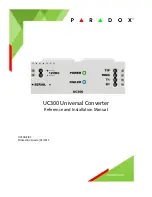
110
SPG8000A User Manual
SDI Picture File Generation
Frame pictures are .bmp files that are used to generate pictures. When
generating signals from frame pictures, the instrument does not filter the video
signal except at the left and right borders of the raster. The unfiltered signal
allows users to control exactly what is generated and to create stressful
patterns.
The instrument allows picture files to be used at resolutions larger and smaller
than the native size of the picture file. If the picture image is larger than
needed, it will be truncated and only the upper left corner of the image will be
displayed.
If the picture file resolution is smaller than the output raster, then the image
will be displayed in the upper left corner of the output, and Black will be
shown in the rest of the image.
The com
bination of not filtering and the use of nonnative image sizes has the
potential to cause problems in several areas:
•
If the video in the frame picture file has fast transitions that exceed the
normal video limits, then the final output may ring excessively an
d
therefore not
be appropriate for transmission. In most cases, the picture
file should be processed to limit the edge speed before it is downloaded
to the instrument.
•
If the video in the frame picture file is not shaped at the edges of the
raster, then there may be ringing if the signal is put in motion. If this is
a concern, then the picture file should be processed to have gradual
transitions at the edges before it is downloaded.
•
If the frame picture file is used at a raster that is smaller than the native
s
ize
of the file, then it will be truncated at the output raster size which
may create unshaped edges. These will be masked for normal
operation, but will be exposed if the signal is set in motion. If this is a
problem, then the user should create a second version of the picture file
that has the
needed
native raster size and has shaped
edges.
•
If a frame picture file is used at a raster size greater than the native size
of the file, then the two edges will inherently end up somewhere inside
the output raster image. If the file has unshaped edges, then the output
may have excessive ringing even when not in motion. If this is a
concern, then the picture file should be processed to have gradual
transitions at the edges before it is downloaded.
SDI Zone Plate Signals
Zone plate video test patterns, or simply “zone plates”, are important tools for
the evaluation of video processing systems and techniques.
They are called zone plates because the classical circular pattern looks like an
optical zone plate (which uses the principles of Fresnel diffraction to focus and
intensify light). Today, however, the name has been applied to a wide variety
of stationary and “moving” test patterns.
Summary of Contents for SPG8000A
Page 53: ...SPG8000A User Manual 39 Figure 7 Removing a Power Supply module...
Page 103: ...SPG8000A User Manual 89 Figure 22 SDI Overlay submenu...
Page 182: ...168 SPG8000A User Manual Figure 61 AES button menu diagram...
Page 190: ...176 SPG8000A User Manual Figure 73 EMBED button menu diagram...
Page 194: ...180 SPG8000A User Manual Figure 77 DOLBY E CONFIG submenu diagram part 2...
Page 197: ...SPG8000A User Manual 183 Figure 81 REF button menu diagram part 2...
Page 200: ...186 SPG8000A User Manual Figure 84 SDI button menu diagram part 2...
Page 211: ...SPG8000A User Manual 197 Figure 96 SDI ANC PAYLOAD submenu diagram part 2...
Page 213: ...SPG8000A User Manual 199 Figure 97 STATUS button menu diagram part 1...
Page 215: ...SPG8000A User Manual 201 Figure 99 SYSTEM button menu diagram part 1...
Page 216: ...202 SPG8000A User Manual Figure 100 SYSTEM button menu diagram part 2...
Page 225: ...SPG8000A User Manual 211 Figure 107 SNMP TRAPS submenu diagram part 2...
Page 240: ...226 SPG8000A User Manual Figure 123 PTP primary master menu diagram part 1...
Page 241: ...SPG8000A User Manual 227 Figure 124 PTP primary master menu diagram part 2...
Page 243: ...SPG8000A User Manual 229 Figure 126 PTP primary slave menu diagram part 2...















































